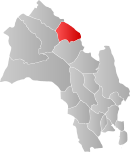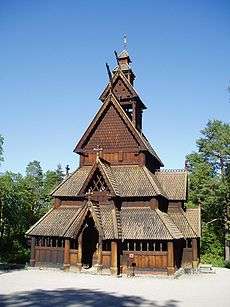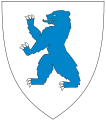Gol, Norway
| Gol kommune | |||
|---|---|---|---|
| Municipality | |||
| |||
 Gol within Buskerud | |||
| Coordinates: 60°45′1″N 8°59′5″E / 60.75028°N 8.98472°ECoordinates: 60°45′1″N 8°59′5″E / 60.75028°N 8.98472°E | |||
| Country | Norway | ||
| County | Buskerud | ||
| District | Hallingdal | ||
| Administrative centre | Gol | ||
| Government | |||
| • Mayor (2003) | Jan-Halvard Brekko (Ap) | ||
| Area | |||
| • Total | 533 km2 (206 sq mi) | ||
| • Land | 514 km2 (198 sq mi) | ||
| Area rank | 200 in Norway | ||
| Population (2004) | |||
| • Total | 4,372 | ||
| • Rank | 218 in Norway | ||
| • Density | 8/km2 (20/sq mi) | ||
| • Change (10 years) | 1.4 % | ||
| Demonym(s) | Goling[1] | ||
| Time zone | CET (UTC+1) | ||
| • Summer (DST) | CEST (UTC+2) | ||
| ISO 3166 code | NO-0617 | ||
| Official language form | Nynorsk | ||
| Website |
www | ||
|
| |||
![]() Gol is a municipality in Buskerud county, Norway. It is part of the traditional region of Hallingdal. The administrative centre of the municipality is the village of Gol. Gol was established as a municipality on 1 January 1838 (see formannskapsdistrikt). The area of Hemsedal was separated from Gol in 1897 to become a separate municipality.
Gol is a municipality in Buskerud county, Norway. It is part of the traditional region of Hallingdal. The administrative centre of the municipality is the village of Gol. Gol was established as a municipality on 1 January 1838 (see formannskapsdistrikt). The area of Hemsedal was separated from Gol in 1897 to become a separate municipality.
The municipality of Gol is bordered to the north by the municipality of Nord-Aurdal (in Oppland county), to the east by Sør-Aurdal (in Oppland county), to the south by Nes, and to the west by Ål and Hemsedal.
General information
Name
The Old Norse form of the name was Gǫrð. This is probably an old river name (for the lower part of Hemsil river). The name of the river is maybe derived from the word garðr m 'fence; border' - and the meaning is then 'the border river'.
Coat-of-arms

The coat-of-arms is from modern times. They were granted on 13 September 1985. The arms are gold with three black keys in the center. The keys are derived from the key for the oldest stave church in Gol Gol stave church, which is now in the Norwegian Museum of Cultural History.[2][3]
History
The mediaeval Gol stave church (built 1216) was due for demolition after the construction of a larger new church around 1880. It was saved from destruction by the Society for the Preservation of Ancient Norwegian Monuments, which bought the materials with the intention of re-erecting the church elsewhere. Financial problems were solved when King Oscar II decided to pay for its relocation and restoration as the central building of his private open-air museum near Oslo, where it was completed in 1885.
In 1907, the royal museum was merged with the Norsk Folkemuseum, which now manages the stave church, still nominally belonging to the reigning monarch. A modern replica has been built as a tourist attraction in a theme park in downtown Gol; the replica is far from the original site of the mediaeval church.
Attractions
Gol Bygdetun, is an open-air museum built around the old Skaga farm, located in the village of Gol. It is dedicated to the cultural history of Gol, and contains farm buildings of nearly all types. The oldest building dates back to 17th century.
Sister cities
The following cities are twinned with Gol:[4]
-
 - Årjäng, Värmland County, Sweden
- Årjäng, Värmland County, Sweden -
 - Fanø, Region Syddanmark, Denmark
- Fanø, Region Syddanmark, Denmark -
 - Virrat, Länsi-Suomi, Finland
- Virrat, Länsi-Suomi, Finland
References
- ↑ "Navn på steder og personer: Innbyggjarnamn" (in Norwegian). Språkrådet. Retrieved 2015-12-01.
- ↑ Norske Kommunevåpen (1990). "Nye kommunevåbener i Norden". Retrieved 2009-01-07.
- ↑ "Kommunevåpenet" (in Norwegian). Gol kommune. Retrieved 2009-01-07.
- ↑ "Venskapskommunar" (in Norwegian). Gol kommune. Retrieved 2009-01-07.
External links
| Wikimedia Commons has media related to Gol. |
| Look up Gol in Wiktionary, the free dictionary. |
- Municipal fact sheet from Statistics Norway
 Buskerud travel guide from Wikivoyage
Buskerud travel guide from Wikivoyage


